Text
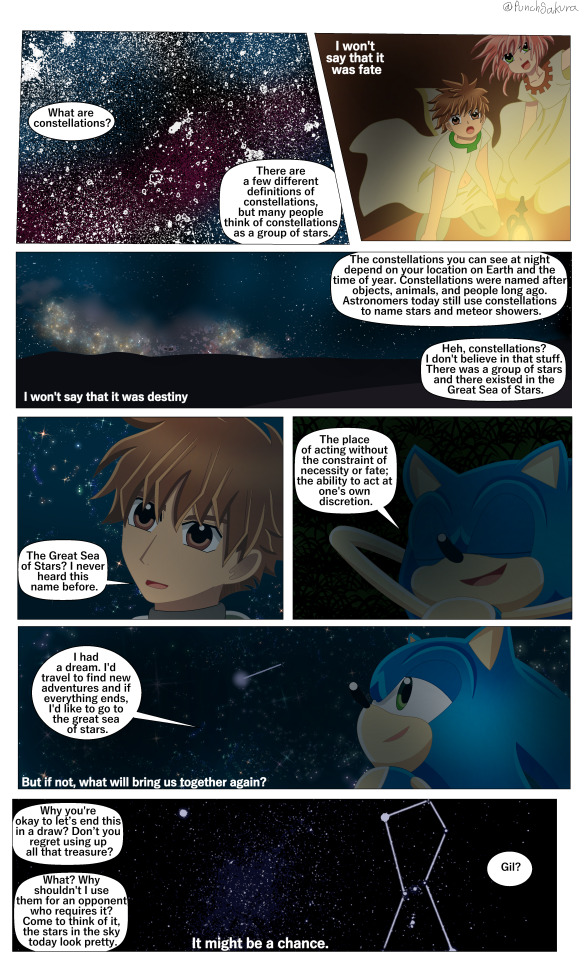
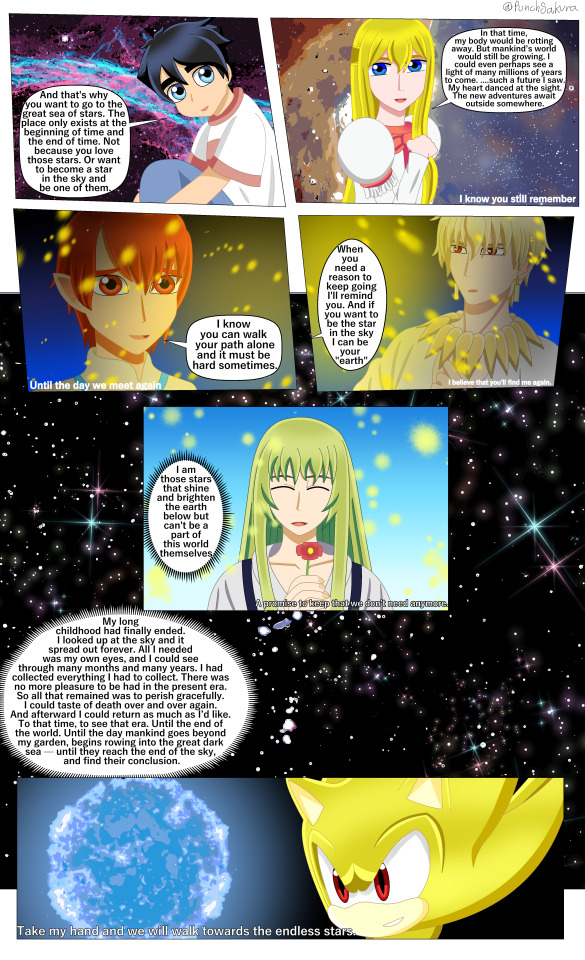
Let's Analysis
Finding the North Star also mean Our Conquest on The Ocean of Stars

Enkidu: Tools need not the northern wind or the sun

But eventually, Punch and King Gilgamesh knew that couldn't last forever. In the end, he will be alone.




Not different in Sonic X Episode 39 how Sonic felt.

They accept the truth in this world or death or the cycle of rebirth and death. They can't accept the way that should be because they're not in that part and not humans. They're like stars that they will be the same.(#the shining stars who give hope) Even when the light vanishes into the darkness, they remain the same. That's why at first they didn't want to make a relationship with anyone. But they didn't understand why they needed someone by their side to guide them. Many planets still receive the light from those stars that shine so brightly. But because without planets, there would be nothing to see just like the sun and the moon, we wouldn't be able to see each other and the beauty of this earth without light.
Peter: When you need a reason to keep going, I'll remind you. And if you want to be the star in the sky. I can be your "earth"
That's the reason behind why King Gilgamesh never abandoned the earth. And....Sonic, Punch and King Gilgamesh are the stars and they(the stars) need a place for them, Syaoran, Peter and Danny are the earth.
Journal for the History of Astronomy: Source
Some concepts in the history of astronomy have seriously affected the development of science and culture in many regions. The concept of zodiac is one of them. The zodiac as a band of constellations, within which visible motions of the Moon and planets occur, played an important role in the astronomy of ancient Mesopotamia, ancient Greece, and countries of Islam. The ideas associated with the zodiac had not only astronomical but also astrological and religious significance. The history of Mesopotamian zodiac is of particular importance, since it had a direct impact on the formation of ideas about the zodiac in ancient Greece and in Islamic countries, and through them in Europe.
The history of the Mesopotamian zodiac is a long and carefully studied issue.1 It is subdivided into two key problems closely related to each other: (1) the discovery of the band of zodiacal constellations through which the Sun, Moon, and five planets move, and (2) the division of the zodiacal band into 12 equal parts to form the so called uniform zodiac used in mathematical astronomy. Sources related to the history of zodiac are cuneiform texts of various types (not only astronomical), dated mainly from the first millennium BC. This article will investigate just one aspect of the zodiac history—the question of when and how a system of 12 zodiac constellations was developed in Mesopotamia. We also set the task of identifying traces of this system directly in cuneiform sources. Surprisingly, in the existing historical and scientific literature this question has not been studied yet. But when examined in detail on the basis of authentic sources, the answer to this question might appear to be not so simple and not so obvious.


The three main astral symbols represented on the kudurrus: a) crescent; b) sundisk; c) star.

Examples of patterns represented on the kudurrus reliefs: a) linear pattern; b) 'triangular shape' pattern.
As you can see From: The Astral Family in Kassite Kudurrus Reliefs:: Iconographical and Iconological Study of Sîn, Šamaš and Ištar Astral Representations. These three symbols will be important and hint at the future.
P.S. Don't think anything romantic yet!
#sakuraswordly#tsubasa of phantasia concept#Tsofph Danny Phantom#sonic crowe#punch whalen#fate gilgamesh#Tsofph Gilgamesh#syaoran tsubasa#tsofph peter pan#princess tsubasa#trc sakura#This blog will continue in Analyze the characters: Gilgamesh's dream and his hope. How valuable Punch is#how important Sonic is and why Sonic is important to both Punch and Gilgamesh.#tsofph#the shining stars who give hope.#the maiden man of the flower
3 notes
·
View notes
Text
Sources on ancient Egyptian music
Manniche, Lise. “Angular Harps in the Amarna Period.” The Journal of Egyptian Archaeology 92, no. 1 (2006): 248–49. https://doi.org/10.1177/030751330609200113.
Dean, Jeffrey. "ancient Mesopotamian and Egyptian music." In The Oxford Companion to Music. : Oxford University Press, https://www.oxfordreference.com/view/10.1093/acref/9780199579037.001.0001/acref-9780199579037-e-261.
O'Dell, Emily Jane. "Music and Musical Instruments in Ancient Egypt." Music and Musical Instruments in Ancient History. Facts On File, 2020. Accessed December 13, 2022. online.infobase.com/Auth/Index?aid=107402&itemid=WE49&articleId=225703.
Bochi, Patricia A. “Gender and Genre in Ancient Egyptian Poetry: The Rhetoric of Performance in the Harpers’ Songs.” Journal of the American Research Center in Egypt 35 (1998): 89–95. https://doi.org/10.2307/40000463.
Ashby, Solange. “Dancing for Hathor: Nubian Women in Egyptian Cultic Life.” Dotawo: A Journal of Nubian Studies 5 (2018). https://doi.org/10.5070/d65110046.
Köpp-Junk, “Textual, iconographical and archaeological evidence for the performance of ancient Egypt Music,” in A.G. Ventura et al., (eds.), The Musical Performance in Antiquity: Archaeology and Written Sources. (In press).
0 notes
Text
Iconographer journalism

Iconographer journalism plus#
Here you will find options to view and activate subscriptions, manage institutional settings and access options, access usage statistics, and more. If you believe you should have access to that content, please contact your librarian.įor librarians and administrators, your personal account also provides access to institutional account management. The institutional subscription may not cover the content that you are trying to access. Oxford Academic is home to a wide variety of products. View the institutional accounts that are providing access.View your signed in personal account and access account management features.
Iconographer journalism plus#
L’iconographe recherche les images les plus adaptes afin d’illustrer des livres, des ouvrages scolaires, des magazines, des articles. Some societies use Oxford Academic personal accounts to provide access to their members.Ĭlick the account icon in the top right to: Mtier Iconographe : missions, formations et salaire. See below.Ī personal account can be used to get email alerts, save searches, purchase content, and activate subscriptions. Some societies use Oxford Academic personal accounts to provide access to their members. If you do not have a society account or have forgotten your username or password, please contact your society. Do not use an Oxford Academic personal account. When on the society site, please use the credentials provided by that society.If you see ‘Sign in through society site’ in the sign in pane within a journal: Many societies offer single sign-on between the society website and Oxford Academic. Society member access to a journal is achieved in one of the following ways: If you cannot sign in, please contact your librarian. If your institution is not listed or you cannot sign in to your institution’s website, please contact your librarian or administrator.Įnter your library card number to sign in. Following successful sign in, you will be returned to Oxford Academic.When on the institution site, please use the credentials provided by your institution.Select your institution from the list provided, which will take you to your institution's website to sign in.Click Sign in through your institution.Shibboleth / Open Athens technology is used to provide single sign-on between your institution’s website and Oxford Academic. This authentication occurs automatically, and it is not possible to sign out of an IP authenticated account.Ĭhoose this option to get remote access when outside your institution. The photos from Abu Ghraib are not photojournalistic. Journalism vectors (121,170) Journalism mass media news people icons vector Journalism concept in pop art vector Background with journalism icons vector. Typically, access is provided across an institutional network to a range of IP addresses. Within the media of photography, photojournalism might be the genre from which most icons are drawn. If you are a member of an institution with an active account, you may be able to access content in one of the following ways: Get help with access Institutional accessĪccess to content on Oxford Academic is often provided through institutional subscriptions and purchases.

0 notes
Photo

Gisbert Combaz - Poster for the Annual Exhibition for La Libre Esthetique of 1902 - 1902
Gisbert Combaz or Ghisbert Combaz (Antwerp, 23 September 1869 – Saint-Gilles, 18 January 1941) was a Belgian painter, lithographer, illustrator, poster artist, furniture designer, sculptor, art educator, art historian and lawyer. He originally trained and practised as a lawyer, but gave up his legal career to dedicated himself to art education and art. He was one of the leading Belgian Art Nouveau artists. Despite his talents as a painter, he is now mainly known for his poster designs and postcards as well as his First World War drawings expressing his hatred for the German occupiers. His work showed a strong influence of his in-depth study of Japanese and Chinese art.
Gisbert Combaz was a versatile personality who combined a variety of artistic pursuits with scholarly studies and academic education. He is mainly known for poster design and postcards and was active as a lithographer, illustrator, furniture designers and potter. He was talented painter whose works show the inspiration of Maurice Denis who also directed him towards religious subjects. His paintings have a decorative character and a great tenderness of tone. He was one of the principal protagonists of the Art Nouveau movement in Belgium.
He was a prolific designer of posters. At the end of the 19th century, the poster was a successful new medium that reflected the aspirations of the bourgeoisie. Aside from encouraging consumption, it evoked moments of pleasure and lightness that were part of the leisure and entertainment of the affluent and influential population. He designed many posters for exhibitions of the artist circle La Libre Esthétique. He developed a personal style which remains very recognizable. It is inspired by calligraphy and Japanese prints. The iconographic repertoire of Japanese artists such as Hokusai and Hiroshige were an inspiration for his compositions. The reference work was clearly the Hokusai Manga, published in 1815 and composed of 15 volumes. From 1897 Combaz designs different posters for the annual exhibitions of the artistic group La Libre Esthétique. Characteristic of his posters is there use of a central theme, such as a boat, a tree, a peacock or an eagle. In addition, his posters are also characterized by a very bright color palette. Combaz mixes the Japanese print style with Art Nouveau elements such an arabesques. Through these posters Combaz gave the Art Nouveau a very powerful and modern form.
Combaz was very effective in transposing the Japanese wood block print style known as ukiyo-e to the medium of posters. In his Poster for the 1895 Expositions Peinture, Sculpture, Architecture, Arts Appliques at La Maison d’art, Brussels, Combaz succeeded like the Japanese masters to express the maximum with a minimum of resources. With the motif of the sailboat treated in a single flat color, his poster gains a great expressiveness equal to that of Japanese prints. Combaz wrote in the journal L'Art moderne that the quality of the Japanese landscapes is their chromatic unity: in each print there is a dominant palette which, by simplifying the impression, makes it strong and confers to these pictures a character of powerful homogeneity. These characteristics were clearly transposed by Combaz to his posters.
Combaz' work further shows the influence of contemporary movements such as cloisonnism and pointillism. His early lithographs are based on a few flat decorative shapes. He then developed towards a cloisonne style of patterned images - birds, figures, land and seascapes - enclosed by a thick dark line. After 1906 he blended cloisonnism and pointillism as shown in some gouaches of oversized flowers in particular of orchids.
Combaz further designed book covers and postcards. Particularly well known are his postcards with designs of the four elements, scenes of the ocean and fishermen, expressions and proverbs. He further created a number of drawings that expressed the horror of the Belgians at the atrocities committed by the German occupiers during the First World War. One of his drawings called Louvain shows the terror of the citizens of Louvain at the burning down of their town by German soldiers on 25 August 1914. Combaz depicted in very graphic detail the horrified people fleeing the town with flames visible in the background of the drawing.
He also tried his hand at sculpture and exhibited sculptures of a lion and a peacock at the Triannual Salon of Brussels in 1919.
62 notes
·
View notes
Text
Thursday 28 November 1839
8 ¾
2 ¼
fine morning F66° at 9 55/.. on my bedroom table – breakfast over at 11 at which hour R +1° = F34° - then reading Russian grammar 20 minutes out at 11, and walked (4 turns) 1 ½ hour and home about 1 5/.. – dressed – Mr. Fischer came at 1 20/.. nearly 10 minutes before I was ready, so that A- and he were tête-à-tête – he civilly (before he himself had read them) brought us the catalogue, Reports and proceedings he had just received from the zoological society of London – and staid till after 2 (about 2 10/.. or 2 ¼) – promised to dine with them on Sunday next at 4pm – very civil – asked him about Kasan, etc. – the greatest cold is generally the end of December and beginning of January but this year is so extraordinary one cannot calculate how it will be – i.e. it is so mild now – the ‘’Reports of the council and auditors of the zoological society of London read the annual general meeting, April 29, 1839. London printed by Richard and John E. Taylor Red Lion court, Fleet street, 1839’ – at pp. 6 and 7 mentions the total no. [numero] of corresponding members = 126 – mentions the Death of Frederic Cuvier born at Montbelliard [Montbéliard] in Alsace in 1773 – always when applied to, gave valuable information ‘and his last and one of his most valuable contributions to Mammology graces the pages of our Transactions’ – Imperishable evidences of his depth of [observation] and acuteness of discrimination in forming new species – are found in the great ‘Histoire des mammifères’ and in several monographies of which the ‘memoir on the Jerboas and Gerbilles’ merits especial notice. His elaborate and comprehensive work. ‘Sur les Dentes de
mammifères considérées comme caractères Zoologiques’ – is less characterized by the novelty and originality of the views and observations which it contains than by the vast no. and useful arrangement of the facts, and their accurate iconographical illustrations : it is essential to the student of mammology, and has already taken its station as a classical work in Zoological Literature’........... ‘But the most original and pleasing productions’ of his pen are the ‘memoires on the Instincts and Habits of animal published in the ‘Annales du muséum d’Histoire naturelle’ they are replete with facts and reflections of great novelty and interest, and are highly characteristic of the peculiar modes of thought and tone of mind of their accomplished author’............. p. 8 It was in the course of one of his tours of inspection, that he was attacked at Strasburg with paralysis; and he died of the same malady and at the same age as his illustrious brother’ p. 12 collection in the museum of mammalian = 1288 specimens;
of which 760 an examples of specimens of these a classified catalogue is printed
total no. of birds exhibited = 5230: 3,000 specimens are named
ditto ditto reptiles = 1000 specimens
ditto ditto fished 1070 are exhibited there are also 83 skeletons mounted
p. 14 the mumagerie at present contains
Quadrupeds 3030
Birds 592
Reptiles 38
933
no books bought in 1839 but those already in course of publication
p. 15 Mm Cuvier and Valenciennes’ Fisher
p. 16 Guerins’ magazine
annales des sciences naturelles
Suites à Buffon
Journal of the Asiatic society of Bengal 1829-1838.
magazine of zoology and botany
Philosophical magazine.
p. 16 Since the last anniversary, has been published Part 3, vol. ii. of the Transactions the Proceedings for 1837 have been completed and issued; and it is hoped that the proceedings for 1838 will be ready for delivery in a fortnight from this time.
p. 22 Funded capital = £11,291.12.7 exclusive of £200 exchequer bills they have petitioned government to reduce the garden-rent = £740 per annum paid to the crown – the expense (see the balance sheets) seem about £14,000 + per annum
vid. ‘A list of the fellows and honorary, foreign, and corresponding members..........’ at the beginning ‘subscription and all other communications are received at no. 28 Leicester square’ admission £5 + £3 per annum payable in advance 1 January if elected after 30 September not liable to pay subscription for that year –
Annual subscription may be compounded for on the usual terms of 10 years purchase or including admission fee £25.
gardens open from 8am to sunset and museum from 10, to 6.
SH:7/ML/E/23/0137
had just written so far and looked over the pamphlets cited now at 3 55/.. hardly light to see to read, except close to the window – dressed – dinner at 5 20/.. to 6 – spare moments before dinner and during dressing read Russian grammar – Foreign members of the London Zoological society = 23
Audoin Victor, Paris.
Blumenbach, J.F. Göttingen.
Cooper, William New York.
De Blainville, Professor Zoology Paris.
De Humboldt., Baron. Berlin.
Desmarest, Anselmo G. Paris
Drapiez. Brussles
Dumeril. Paris
Ehrenberg, Christian Gottfred. Berlin.
Fischer, Gotthelf. Moscow.
Lesson, R.P. Paris.
Lichtenstein, Henry. Berlin.
Majendie, F. Paris.
Musignano, Prince of. Rome.
Ord, George. Philadelphia
Reinwardt, C.G.C. Leyden
Rüppell, Dr. Edward Frankfort on the Maine.
St. Hilarie, Geoffroy. Paris
Savi, P. Pisa
Savigny. Paris
Temminck. C.G. Leyden.
Tiedemann, Frederick Heidelberg
Valenciennes, A. Paris
i.e. 9 Paris
3 Berlin
2 Leyden
1 Brussels
1 Göttingen
1 Heidelberg
1 Frankfort on the Maine
1 Moscow
1 New York
1 Philadelphia
1 Pisa
1 Rome
23
then reading over the different continuations of the Transactions etc. till now 6 35/.. – then dawdling – expecting count Panin to go with us to the theatre – had given him up, and we were just setting off to the Ourousoffs’ when he arrived at 7 20/.. – the piece began at 7 – arrived at the grand theatre about 7 ¾ - the 1st act over – the nymphe of the Danube – large, very handsome house and pretty full – the orchestra good – 3 double rows of performers = I should guess about 24x3 = 72 – the pit divided as in Paris the part under the front boxes being not quite so large as the other – 5 tiers of seats exclusive of the bottom rez de chaussée tier – no private boxes as in London and Paris, but
went to the grand theatre
divided off as in common theatres .:. all equally exposed to view – scenery very good – and very fair dancing – a Mademoiselle Sancouski or San...... something a pretty enough little person of 20+ danced graciously and well, and the [?] of the principal male performer good – the principal male dancer very fair – the ballet very well got up – our friend the husband of our opponent at whist last night came and sat with us perhaps 10 minutes very civil – Mr.............. I did not catch his name – perceiving at 9 50/.. that the piece was just over, we came away – home at 10 – Rather rainy night going and returning – count P- is 2 verschoks taller than the emperor (16 verschoks = 1 archine) and Pierre le grand was 1 ½ verschoks taller than count P- then had Grotza – then tea till 11 ¼ - then till 12 20/.. reading the St. James’s chronichle of Thursday 19 to Saturday 21 September and then read the 1st page of the same from 21 to 24 September vid. p. bottom of col. 5 – Mr. Ceely surgeon, of Aylesbury, has demonstrated that small pox and cow-pox have the same origin, the latter being small pox communicated to the cow – Mr. Ceely innoculated [inoculated] cows with small pox matter – the vesicle produced was the vaccine pock – children were innoculated [inoculated] with the matter thus produced ‘the result was, a fine, genuine vaccine vesicle – the children were afterwards innoculated [inoculated] with small pox matter, and found to be protected from the disease – this new matter, truly variola vaccine, has been employed with perfect success at Bristol – It is now only necessary to innoculate [inoculate] cows with small pox matter – vid. Bristol Journal
now at 1 5/.. had just read thro’ the paper from Saturday 21 to Tuesday 22 September 1839. fine day, but damp and rainy evening (vid. line 7 of this p.) F68° on my table in the salon now at 1 5/.. and R +2 ½° = about F37° outside – then till 1 25/.. read thro’ the paper from Tuesday 24 to Thursday 28 September 1839. this being the last of the 3 papers sent to us by Mr. Camidge yesterday – Fischer (speaking of diamonds this morning) said good of 1 carat = 60/. which [?] on increased in value four-fold per carat .:. of one carat = 60/. of two carats = 60x4 = 240, of three carats = 240x4=960 and so on – when F- wants precious stone he buys them of............... a German bijoutier, near the great theatre – one should always buy diamonds by weight -
5 notes
·
View notes
Text
Happy Indigenous Peoples’ Day!
10/12/20:
So. If you’ve been here a year or more, you might know that I have this little journal from back in 2018 that I try to update every year with works from local indigenous artists / created in collaboration with indigenous folks.
It was once hosted on another site, but that one’s since gone to hell! So, I’m shuffling it over here and giving it a little TLC : -) Enjoy!
◆
10/8/18:
You can probably glean from my work that I owe intensely to the people of the Sonoran Desert and surrounding communities. Since it’s Indigenous Peoples’ Day, I’m going to share a few works from (mostly southwestern) native artists that have really impressed on me. If you enjoy anything that I do, I think you’ll enjoy their work even more!
Tyler Bighorse and Suite 104
I was introduced to the work of Tyler Bighorse in downtown Flagstaff, where he runs a gallery called Suite 104.
If you're ever in the area I really recommend dropping by! He sells prints and originals of his works there, as well as other local artists' work. (snagged this sick Legend of Zelda spread for my bro while I was up there.)

Mulaka, by Lienzo
youtube
Synopsis, from their website:
Dive into northern Mexico’s breathtaking landscapes with Mulaka, a 3D action-adventure game based on the rich indigenous culture of the Tarahumara. Renowned for their impressive running abilities, embark on the journey of a Sukurúame - a Tarahumara shaman - as you fight back the foulness corrupting the land, while drawing upon the powers of demigods.
Mulaka was developed by the Chihuahua-based game company Lienzo in conjunction with Rarámuri leaders and anthropologists. Lienzo also aims to keep their game dev local to Chihuahua, which I think is extremely badass.
And the music just. rules. ( Town of Paquimé / Nini Areware Ne Chunume )
Quantum Tangle (Grey Gritt and Tiffany Ayalik)
Quantum Tangle is really really good. Like, really really good. Blurb from their old bandcamp:
Fusing of old-world sounds and new-world flair, the Juno Award-winning group Quantum Tangle is embracing their blended background. Combining their talents of throat singing, haunting melodies and traditional legends, Grey Gritt and Tiffany Ayalik are excited to present pieces that look back through history to challenge, educate and encourage the next generation to be socially aware.
The unfortunate news is that their website went down earlier in the year : -( But the good news is their work is still floating around the internet. I believe you can find them on Spotify and other streaming services as well. Here is a favorite, a love ode of sorts called Igluvut:
youtube
My other favourites for first-time listeners are Love is Love pt. 2 and Tiny Hands : -)
Oral History of the Yavapai, by Mike Harrison and John Williams
Three tribes of Yavapai got together at Bloody Basin. Kewevkepaya, Wipukpa and Yavepe. Three of them. They get together and cook mescal, cook deer. Get together and eat, dance and have a good time. But the soldiers met them there and killed them. Then the White people called the place Bloody Basin. Called it after our blood.
- Oral History of the Yavapai I originally stumbled across this book (in reality a word-for-word chronicle of oral history told by Mike Harrison and John Williams, two Yavapai elders) through one of the sources cited in this blog post: The True Victims of “Bloody Basin” Were the Yavapai.
It really struck me, because to that point all major publications that I'd read had unquestioningly ran the old U.S. Army account of how Bloody Basin got its name (Check out the Verde Independent’s article here, and AZcentral’s take here.) It frames the massacre not only as a “punitive expedition,” but also incorrectly names the victims as Tonto-Apache-- The Dilzhe’e are a distinct people, though the Yavapai people were often conflated with them. It’s much harder to get folks into books, but if you have any interest in the history of the Salt River Valley or surrounding areas at all, this was an invaluable read to me. Be aware that it is vibrant and devastating in equal measures-- but if you can handle it, I highly recommend it.
◆
10/14/19 Additions
The writing of Darcie Little Badger
The Whalebone Parrot and Owl Vs. The Neighborhood Watch were my introductions to Darcie's work and they are so, so full of wit, character, and ghoulish suspense... the kind of stories you would read to family and friends as Halloween closes in, this time of year. I am only familiar with her mystery and horror-adjacent short stories at the moment, but I hope to become better acquainted with her body of work in the near future. You can find a list here, many of which you can read online for free!
Anyway. Let me leave you with the Inherent Horror of Birds (from The Whalebone Parrot,) which I don't think I've seen any other writer capture so artfully:
I wonder if all parrots have dancing eyes. The pupils are in a state of constant flux, contracting and expanding. Big, small, big, small.
“What song is that?” I asked. Her pupils danced: large, small, large. She possessed parrot eyes and parrot songs.
10/12/20 Update: Darcie Little Badger recently published her first book, Elatsoe! Check it here : -)

Imagine an America very similar to our own. It’s got homework, best friends, and pistachio ice cream. There are some differences. This America has been shaped dramatically by the magic, monsters, knowledge, and legends of its peoples, those Indigenous and those not. Some of these forces are charmingly everyday, like the ability to make an orb of light appear or travel across the world through rings of fungi. But other forces are less charming and should never see the light of day.
Seventeen-year-old Elatsoe (“Ellie” for short) lives in this slightly stranger America. She can raise the ghosts of dead animals, a skill passed down through generations of her Lipan Apache family. Her beloved cousin has just been murdered, in a town that wants no prying eyes. But she is going to do more than pry. The picture-perfect façade of Willowbee masks gruesome secrets, and she will rely on her wits, skills, and friends to tear off the mask and protect her family.
The pottery of Nathan Youngblood
youtube
I learned of Nathan Youngblood's work scarcely a week ago, during a visit to the Heard Museum, and it very nearly made me start hooting and hollering in the middle of the museum. It is, without exaggeration, unlike any kind of craft I've ever seen before. His work is something of a marriage between the Santa Clara pottery tradition with Asian ceramics and other traditions world-wide, and it's a coupling that is at once startlingly familiar and yet completely unique.
The art, writing, and games of Elizabeth LaPensée
Elizabeth is perhaps best known for creating Thunderbird Strike!
vimeo
(synopsis from its website: )
In the 2D sidescroller Thunderbird Strike, fly from the Tar Sands to the Great Lakes as a thunderbird protecting Turtle Island with searing lightning against the snake that threatens to swallow the lands and waters whole.
But she has a very wide and rich body of work, and among my personal favourites are her visual art. She employs digital collage to create these sort of iconographic pieces, and to me there's a certain joy in the way her work employs silhouette and contour, tracing the shape of a body, the environment within that body, and its place in its environment. It's not something that I can really do justice by describing, so here's a favourite from her ("Thunderbird Circles") that I have on my wall:

44 notes
·
View notes
Quote
Paddington [Bear] is resolutely urban, living in the vicinity of the Portobello Road. He has a bank account, a tailor, rides in cars, engages in a middle management lifestyle (though never, perish the thought, in productive labour; mustn’t give kids the thought that life is hard). Pooh is a creature of pastoral, rarely straying from the confines of the Hundred Acre Wood and, for all his iconographic function for the middle class, he himself transcends class, just as Colin Clout , Hobbinol, Strephon and Phyllida do. Creatures generated by literary convention alone, the class struggle passes them by. They live the intuitive life of natural man (or bear – though Pooh, of course, a most unnatural bear by any zoological reckoning.)
Angela Carter, ‘Animals in the Nursery,’ in Shaking a Leg: Collected Journalism and Writings (p. 370)
8 notes
·
View notes
Text
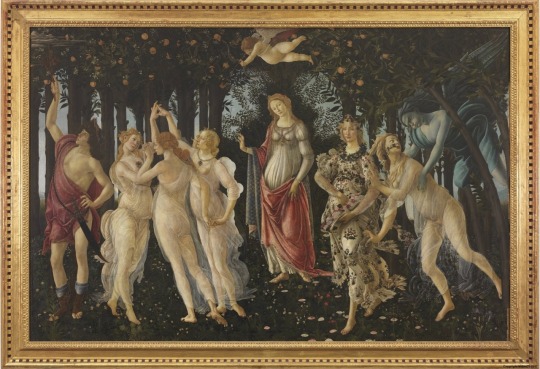
ICONOGRAPHY II: Botticelli’s Primavera
La Primavera is a modern title of convenience given to Botticelli’s picture, painted around 1478/80, of Venus standing in an orange grove with 8 other figures also drawn from classical mythology. The seasonal emphasis implied by that title is confirmed by the depiction of the transformation of Chloris, pursued by Zephyr, into Flora; by the figure of Mercury dispelling the clouds; and flower-strewn verdure. Vasari’s statement that the painting shows “Venere che le grazie la fioriscono, dinotando la primavera,” seemingly explains the relationship of Venus and the Three Graces to the vernal theme.
The painting is therefore not an illustration of a passage from an ancient text. Rather, figures and incidents from classical poetry and mythology have been lifted from their original contexts and grouped together to form a quattrocento allegory of Spring. Gombrich phrases this in more art historical terms when he affirms “the hypothesis that Bottcelli’s mythologies are not illustrations of existing literary passages, but that they are based on “programmes” drawn up ad hoc by humanists.”
However, as Gombrich also states in aside, Vasari’s description of “the Three Graces decking Venus with flowers” is inaccurate. The Graces dance, while Venus’ either directs the dance or keeps musical time. Shorn of its floral component, this group of figures cannot be said to “denote Spring,” and the hypothetical allegory of Spring collapses due to the lack of participation of nearly half of the painting’s figures. The allegory of Spring also fails to obtain if the actions of Mercury are interpreted not as the ending of bad winter weather, but applying the symbol and intrument of peace, the caduceus, to the clouds of war or civic dissension.
Reduced to the Flora group and a flowery ground, the allegory of spring would have to compete with one or two other allegories of uncertain meaning. It is unlikely that one of the eminent humanists employed by the Medici would have devised a disjunctive iconographic programme for a major artistic commission or have employed the machinery of allegory to signify a simple seasonal concept. Spring, therefore, is probably not the primary meaning of the picture.
Since Aby Warburg’s dissertation in Botticelli’s Primavera and Birth of Venus, scholars had accepted the poetry of Poliziano as the source of the picture’s iconography. Gombrich argued, however, that a letter from Marsilio Ficino to his student, Lorenzo di Pierfrancesco de’ Medici, provided if not a direct source for the picture’s iconographic program, then a particular, documented set of circumstances that suggest how it was intended to be interpreted. In his letter exhorting his 14-year old pupil to conduct him life virtuously, Ficino constructs an allegory consisting of pagan gods who represent virtues or qualities. For example, Jupiter is: the law, Mercury is reason, Mars speed, and Saturn slowness. Venus personifies not love, but humanitas, the Ciceronian ideal of an eloquent, urbane, cultured mode of existence emulated by the Florentine bankers.
Due to its wholly unconventional nature, Ficino’s alleogry required not only a detailed written exposition, but also the assistance of two other humanists who were asked by Ficino to reiterate and explicate it for his young pupil. Ficino also explains to his colleagues that visualizing his moral system as pagan deities will make the lesson more vivid and memorable. These efforts to instill in the mind of Lorenzo an understanding of Venus as humanitas takes place at exactly the moment when Botticelli’s picture of Venus was commissioned to decorate Lorenzo’s new residence. Gombrich argues that the young Lorenzo’s understanding of the painting would have been influenced by Ficino’s eccentric conception of Venus. Furthermore, Ficino and Botticelli were both members of the Neoplatonic circle of Lorenzo il Magnifico and both were employed by Lorenzo di Pierfrancesco. Given these circumstances, it seems likely that Ficino devised the iconography of the Primavera. The picture could therefore be understood as a collaborative effort by Ficino and Botticelli to instill in the younger Lorenzo Neoplatonically-inflected humanistic values that would inspire him to emulate the enlightened patronage of his uncle.
Edgar Wind strenuously criticizes Gombrich’s article in his discussion of the Primavera.
Ersnt Gombrich, “Botticelli’s Mythologies: A Study in the Neoplatonic Symbolism of his Circle,” Journal of the Warburg and Courtauld Institutes 8 (1945), 7-60.
Aby Warburg, Sandro Botticellis Geburt der Venus und Frühling: Eine Untersuchung über die Vorstellungen von der Antike in der italienischen Frührenaissance (Strasbourg, 1891).
Edgar Wind, Pagan Mysteries of the Renaissance (New York, 1958).
#italian painting - 15thc.#sandro botticelli#renaissance art#primavera#quattrocento#ernst gombrich#aby warburg#neoplatonism
31 notes
·
View notes
Photo

Iron Mask and Collar for Punishing Slaves, Brazil, 1817-1818 See also https://twitter.com/jmjafrx/status/1258396705302740992?s=20 Aragos voyage took place between 1817 and 1820, during which time close to two months (early December to the end of January 1818) were spent in Brazil, particularly Rio de Janeiro. The engraving shown here, based on a sketch by Arago, is captioned Chatiment des Esclaves, Brasil (Punishment of Slaves). It shows an unidentified male and probably represents a composite of several enslaved Brazilians who Arago observed in the streets of Rio. This illustration is often confused and misidentified in secondary sources on slavery. Among other errors, such sources identify the subject as a woman, but Arago quite explicitly refers to the figure as a man. For a detailed discussion of this image and its historical context, see J. Handler and A. Steiner, Identifying Pictorial Images of Atlantic Slavery: Three Case Studies, Slavery and Abolition 27 (2006), 56-62. The transformation of this image in Brazil in modern times to represent a martyred female slave is discussed in J. Handler and K. Hayes, Escrava Anastacia: The Iconographic History of a Brazilian Popular Saint, African Diaspora: Journal of Transnational Africa in a Global World 2 (2009), 1-27. Source Jacques Arago, Souvenirs d'un aveugle. Voyage autour du monde par M. J. Arago . . . (Paris, 1839-40), vol. 1, facing p. 119 Description and source via slaveryimages.org #ADPhD #slaveryarchive https://instagr.am/p/B_7FAZiATnE/ Follow #ADPhD on IG: @afrxdiasporaphd
11 notes
·
View notes
Text
THE ENDYMION SARCOPHAGI
THE ENDYMION SARCOPHAGI




Above: c. AD 180, Napoli, Museo Archeologico Nazionale; c. AD 220, New York, Metropolitan Museum of Art; ditto; 3rd c., Malibu, Getty Villa.
Below: early 3rd c., Rome, Galleria Doria Pamphilj; Gallo-Roman, early 3rd century, Paris, Musée du Louvre; 3rd. c. Rome, Musei Capitolini; mid 2nd c., New York, Metropolitan Museum of Art.




The textual sources for the myth of Endymion recount, with some variations, how Silene, the goddess of the moon, became enamored of the shepherd, Endymion, on whom she would gaze as he slept in a cave at night. To preserve his great beauty, she asked Zeus to grant him eternal youth, to which Zeus added eternal slumber. Every night thereafter, Silene interrupted the progress of her chariot across the night skies to visit the somnolent shepherd, and eventually bore 50 of his children.
Beginning in the mid second century, the old pagan custom of cremation was gradually supplanted by inhumation. The volte-face in Roman funerary practices reflects newly-emergent conceptions of eternal life and the afterlife of the body, which some have attributed to the infiltration of Christian beliefs into Roman culture.
Those new conceptions are registered in the iconography of Roman sarcophagi. Familiar stories and/or characters from Greco-Roman mythology (Dionysius, the Nereids, the labors of Hercules, etc.) were given new allegorical interpretations appropriate for a funerary monument. With its emphases on timelessness, incorruptible flesh, and eternal sleep as opposed to death, the myth of Endymion provided family members of the deceased with a comforting vision of what awaited their departed loved one—and themselves—on the other side.
Readymade and mass-produced by Greek sculptors, the Endymion sarcophagi are compositionally formulaic. On the long, low type of the Antonine period, Silene steps off her chariot and strides purposively towards the passive, reclining (often clothed) Endymion. Putti attending Silene draw the goddess to his cave. On the left, Silene resumes her journey.
In the third century, the figure of Endymion transforms from simple shepherd to Greek heroic nude. In order to fill the larger walls of the lenos-type sarcophagus popular in the 3rd century, the basic iconography was expanded was enriched. As exemplified by the grand lenos sarcophagus in New York, a profusion of allegorical personifications and secondary figures now fill the periphery of narrative. This densely layered approach, stresses the cosmological setting the Endymion myth at the expense of compositional clarity.
The embossed lion's heads on the second New York sarcophagus resemble the spouts on wine fountains, while other Endymion sarcophagi depict putti bringing in the vintage. These allusions to wine probably reflect the deceased’s participation in Dionysian mystery cults, the rituals of which conceptualized sexuality and cyclical rejuvenation as harbingers of an eternal life after death. Those beliefs complement the themes of the Endymion myth perfectly. Together the two themes form a coherent iconographic statement.
Over 70 Roman sarcophagi depicting the Endymion myth survive from the Antonine and Severan periods. The large number of survivals attests to the myth’s popular appeal.
Further reading:
Matz, Friedrich. 1957. "An Endymion Sarcophagus Rediscovered." Bulletin of the Metropolitan Museum of Art, 15(5): pp. 124–28.
McCann, Anna Marguerite. 1978. Roman Sarcophagi in the Metropolitan Museum of Art. no. 4, pp. 21-22, 24, 36, 39-44, 97,106, 110, 119, 121-22, figs. 35-41, New York: The Metropolitan Museum of Art.
Sorabella, Jean. 2001. "A Roman Sarcophagus and its Patron." Metropolitan Museum Journal, 36: pp. 67–79, figs. 1–5, 8.
83 notes
·
View notes
Photo




Caladrius
The Caladrius is a miraculous healing bird, believed to range from Europe to Jerusalem. It is generally believed to have originated from the stone-curlew, with other influences including seagulls, falcons, herons, ibises, owls, and any of a number of plovers (Charadriidae).
A caladrius is a waterbird the size of a hen or dove. It has immaculately white plumage, with a long neck, yellow eyes, beak, and legs, and rarely straight goat’s horns. Earlier accounts refer to it as being yellow, while others grant it reddish wings, spots, and a yellow-tinged dark color. It is an unclean bird and must not be eaten.
In its simplest form, the caladrius will cure jaundice by returning the stare of a patient who gazes intently at it. This connection to jaundice was inspired by the striking, staring yellow eyes of the stone-curlew. Its dung and the marrow of its thigh-bones will cure blindness.
A caladrius knows if a patient will live or die. It will look at someone who will be cured, and look away from someone doomed to die. Sometimes all it takes to be cured is touching the caladrius. The caladrius touches its beak to the patient’s mouth, taking disease and sickness into itself, and flies into the sky, where the sun burns the illness into oblivion.
This equates the pure and flawless caladrius with Christ, as it looks at and heals the faithful, granting them life, taking sins away in the process. The caladrius was iconographically represented in the role of a healer, sitting on the bedstead of a sick person and either looking to or away from the patient.
It was often kept in the court of kings for its curative powers. The sale of live caladrius was a potentially lucrative business, but merchants had to hide their specimens to avoid having people come in to see them and get cured for free.
References
Aelian, trans. Scholfield, A. F. (1959) On the Characteristics of Animals, vol. III. Harvard University Press, Cambridge, Massachusetts.
de Beauvais, P.; Baker, C. ed. (2010) Le Bestiaire. Honoré Champion, Paris.
Druce, G. C. (1912) The Caladrius and its Legend, Sculptured upon the Twelfth-Century Doorway of Alne Church, Yorkshire. Archaeological Journal, vol. 69, pp. 381-416.
del Hoyo, J.; Elliott, A.; Sargatal, J.; Christie, D.A.; & de Juana, E. (eds.) (2013) Handbook of the Birds of the World Alive. Lynx Edicions, Barcelona.
White, T. H. (1984) The Book of Beasts. Dover Publications, New York.
Wright, T. (1845) The Archaeological Album. Chapman and Hall, London.
#occult#mythology#dark#gore#trippy#obscure#evil#creature#legendary#witchcraft#magic#folklore#greek#vaporwave#aesthetic#monster#lore#alchemy#blackandwhite#rgb#photooftheday#haunted#creepy#scary#lost#history#dead#nature#animals#fable
3 notes
·
View notes
Photo

Starry Night (1889), By Vincent Van Gogh
Hello my name is Samuel Van Alstine, I am a design student and also one of seven boy's raised in the Virginian Appalachian foot hills. I got #5, Vincent Van Gogh's 1889 Starry Night. At first sight I felt the artist attempt at displaying a sense of peace and calmness. Van Gogh's ability to display beauty and amazement through his impressionist style has always amazed me.
1. Van Gogh was an expressionist post-impressionist artist.
2. Van Gogh was the oldest of six brothers.
3. Before committing himself to art Van Gogh worked as a langue teacher and a preacher in London.
4. Van Gogh thought of himself and referred to himself as a "madman".
5. Van Gogh's art career was short, only lasting ten years.
After reading about Van Gogh's life and my view of his art changed slightly. At first glance I though that Starry night was a peaceful look over and beautiful hight sky but then after reading about how depressing his life was I defiantly saw a sense of hopeless loneliness. I still love this impressionist painting but my view has defiantly changed. The distant look over the town makes me feel secluded. The dark colors add a sense of loneliness and depression but the bright lights of the night sky do add a pricing effect of hope, which may have been Van Gogh's purpose.
Part 2

This a watercolor painting created woven paper. This beautiful iconographic scripture painting was created by my sister-in-law for my 20th birthday. This painting is very important to my, not only for its beauty, but for its deep emotional meaning to me and my life. This is a passage from my favorite Psalm in the Old Testament Bible. I often gaze at it when I am feeling down or lonely, when I feel like I’ve lost my way and it reminds me of the love that my family has for me and the Love and peace that I find in the Lord.
Part 3
What Am I? When I think of myself as an art piece I tend to think of myself as a chaotic Jackson Pollock painting. When I look at art I tend to bring a nostalgic and pessimistic view. I see all of the pain and suffering in the world, and in my life, and try to draw something beautiful out of the art that I’m looking at. I guess that you can say I a hopeless romantic and and looking for the reassurance of something pure and beautiful. I am one of seven boys raised in the Appalachian Mountains of Central Virginia. My triplets brother and I are 20 years old, which is crazy to think about. I tend not to think of gender and ethnicity when I describe myself, I am white and I am a male but those two thing do little to explain a person and their experiences. For the past two years I have mowed greens at a golf course with a crew of 13 Mexican-Americans and my brother. But what makes me uniquely me is my relationship with the the Lord and my love for and talent in art. I have drawn and painted for as long as I can remember, but I find myself being drawn to all types of art. I am a frequently journal and right poetry and play music, whether its the guitar of the drum kit. I believe that art is the best way to relate to the creation, and if you believe the Creator. It is how I relate and communicate to the world and those around me.
Part 4
I think that this selfie of me best represents me.

Monochrome is my favorite form of photography. I think that it paints adequate picture of how most people see themselves and the world around them while leaving room for our imagination to fill in color and value. It’s an amazing media.
1 note
·
View note
Photo


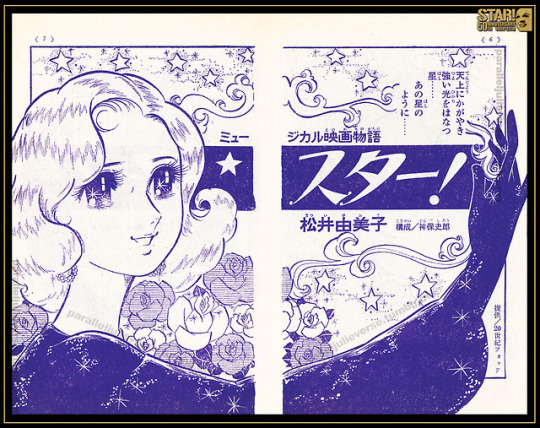
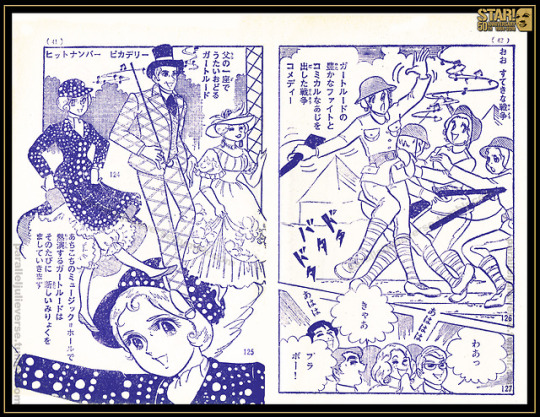






Truth, they say, is ofttimes stranger than fiction…stranger even than the feverish flights of fiction occasionally dished up by the Parallel Julieverse. Case in point, this Japanese manga based on the 1968 Julie Andrews musical, Star! Yep, that’s right, alongside Astro Boy, Doraemon, and One Piece, Julie Andrews has been immortalised as a sparkling doe-eyed manga STAR!
As mentioned in previous posts, the Japanese –– discerning ones, at least –– love Julie. They also love manga. So combining the two into this lavish 130-page comic book edition of Star! likely seemed the most natural thing in the world back in 1968. And unlike Western comic book cultures which have, for the most part, been geared towards children, manga enjoys wide cultural appeal in Japan, popular across all ages and social strata (Johnson-Woods, 2010).
Timed to coincide with the Japanese release of Star! in August/September 1968, this manga was issued as ‘book of the month’ by Nakayoshi, the leading magazine for teenage girls and young women (Schodt, 92). It was written and illustrated by Yumiko Matsui, part of the influential post-war wave of female mangaka (manga artists) who rose to prominence in the 60s and 70s and helped pioneer new forms of female manga or shōjo manga. Created by women for women, shōjo manga were notable for their bildungsroman-style stories of self-realisation and emotional expression centred on complex, strong female protagonists. They also developed a distinctive aesthetic of ‘cuteness’ or kawaii that continues to the present day with wide-eyed moon-faced characters, flowery motifs and decorations, and sentimental images blended into multi-layered panels (Toku, 1-8).
While most shōjo manga were based on original story ideas, albeit of a fairly stock melodramatic kind, there was an important trend in the 60s and 70s of trans-media adaptations where manga were developed from popular films, TV programmes, and even real-life figures of the time like royalty, sports stars and pop singers (Kálovics, 14-15). Yumiko Matsui worked across a range of shōjo formats but she produced several of these trans-media adaptations. Other than the Star! book, she also created a manga based on Pinky and Killers, a popular Japanese band of the time who had their own TV series, one about the Vienna Boys Choir, and another based on the American Boys’ Town Choir. Matsui even produced a manga adaptation of the ‘other’ big diva musical of 1968, Funny Girl––though, unlike Star!, it was only a short story in a weekly magazine and not a standalone book…sorry, Babs!
Drawn according to the highly coded iconographic style of shōjo manga –– large eyes, flat faces, small nose and mouth, etc –– the characters in the Star! manga look precious little like their screen counterparts. However, costumes, settings and other aspects of mise-en-scene are copied quite faithfully from the film, suggesting Matsui worked closely from production stills in creating the book. The manga also follows the basic narrative arc of Star!, depicting the big musical numbers and key dramatic scenes, but it inflects and varies the plot to better accommodate the core conventions of shōjo.
In an obvious effort to broaden the story’s appeal to a young female readership, the manga spends more time on Gertie’s childhood with an expanded backstory about her family life –– which is represented as a much more sanitised upper class family than in the film ––and includes a detailed section about her school years at the Italia Conti Academy. Noël Coward features as Gertie’s childhood ‘gay pal’ and lifelong confidante throughout, and, as in the film, Gertie goes through a series of broken romances –– though, in keeping with the melodramatic worldview of shōjo manga, Gertie is cast in a decidedly more virtuous light as ‘more sinned against than sinning’.
The manga’s biggest departure from the film is the expanded role afforded Gertie’s daughter, Pamela. In the film, Pamela really only pops up in two scenes –– first, as a baby, then on a brief school holiday visit –– but, here, she is a more constant presence in the story and an emotional focus of Gertie’s life. Indeed, the mother-daughter bond is a key theme of the manga with several interpolated episodes showing Gertie and Pamela together in moments of emotional intimacy. The book even culminates with an idyllic mother-daughter reunion at Gertie’s wedding with the final panel framing Gertie and Pamela in a loving embrace.
These various plot changes were presumably made to better accord with the dominant themes and conventions of shōjo manga but they also have the incidental effect of creating a revised characterisation for Gertie that is more attuned to the sympathetic qualities of the traditional Julie Andrews star image: virtuous, caring, maternal. Relative to the film, the manga really does give us “Julie as you love her! Singing! Dancing! Being a Good Sort and Loving Mum!” Who knows, had Robert Wise got Yumiko Matsui to write the screenplay, Star! might have been another Julie Andrews hit?!
Finally, if the Star! manga isn’t already a case of fabulousness overload, the back cover catapults things into utter Julie-fan meltdown with an advertisement for a souvenir Star! beach tote bag. I’ll just repeat that phrase so the magnificence of the concept can sink in: a souvenir Star! beach tote bag! Who knew such a thing even existed, let alone could be picked up in 1968 for the bargain basement price of 20 Japanese Yen?! As God is our witness, the Parallel Julieverse will not rest till we are swanning down the high street with one of these beauties swinging gaily off our arm!
Sources:
Johnson-Woods, Toni, ed. Manga: An Anthology of Global and Cultural Perspectives. New York and London: Continuum, 2010.
Kálovics, Dalma. “The missing link of shojo manga history: The changes in 60s shojo manga as seen through the magazine ‘Shukan Margaret’.” Journal of Kyoto Seika University. 49, 2016: 3-22.
Matsui, Yumiko. Star! / スター! Nakayoshi Book 9. Tokyo: Kodansha, 1968.
Schodt, Frederik L. Dreamland Japan: Writings on Modern Manga. Berkeley: Stone Bridge Press, 1996.
Toku, Masami, ed. International Perspectives on Shojo and Shojo Manga: The Influence of Girl Culture. London and New York: Routledge, 2015.
Copyright © Brett Farmer 2018
#julie andrews#star!#star!50#japan#manga#shojo manga#スター!#ジュリー・アンドリュース#少女漫画#松井由美子#fiftieth anniversary#Twentieth Century Fox#musical#hollywood#classic film#Robert Wise#Co-stars of Star!
56 notes
·
View notes
Text
ARTIST RESEARCH
JOAN MIRÓ
Punyet Miró, Joan, et al. Miro: In His Studio. Thames and Hudson, 1996.


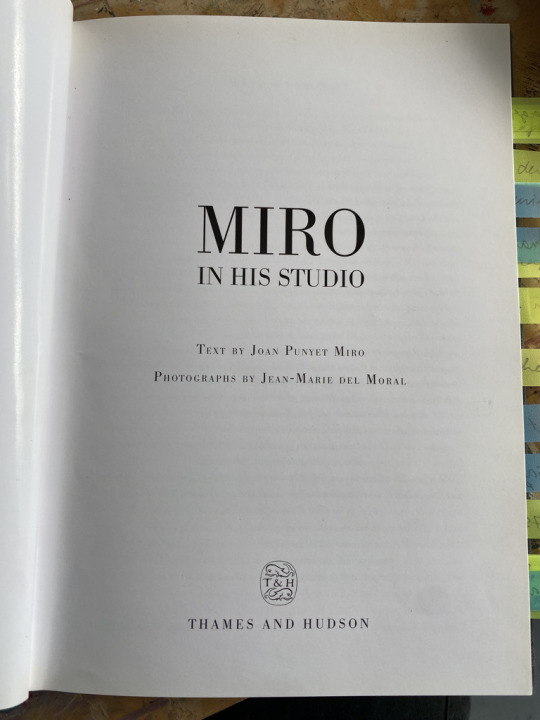
It was suggested that I look into Joan Miró and so I went to the library and got the book ‘Miro: In His Studio’ out. It’s mostly a book of photographs from in his studio but there are a few pages of written content about Miro’s life and practice.
Below are a few quotes and paragraphs from the book that I thought were interesting and relevant:
“Not many photographers were given the opportunity of photographing Miró in his studio, because the artist could not endure the presence of strangers in his working quarters” (Punyet Miró, et al. 8).
“'I paint what I am, ’ declared Miró one day, with reference to his own taciturn, over-sensitive and melancholic temperament. His paintings reproduce perceptions and objects which, having been submitted to a process of transformation and metamorphosis, have assumed the new identity attached to them by the artist. This process occurs automatically and/or subconsciously” (Punyet Miró, et al. 8).
“'My painting bears no resemblance to a private journal. It is an irresistible compulsion that manifests itself externally,’ he said in 1978. This necessity to reveal the irresistible compulsion externally undoubtedly helped him to battle on and, finally, to continue to live” (Punyet Miró, et al. 8).
“An evening walk together in his garden was the best way of entertaining his world; he used to teach me how to listen to the silence, how to look at things in the dark, how to communicate without words. His blue eyes, in which could be read the avidity and lightness of his soul, transmitted this intangible poetry”. (Punyet Miró, et al. 9).
“Throughout his life he was obsessed with freedom of expression, made manifest in a plastic and iconographic idiom that could be understood by all, but which he alone was capable of producing. 'I never dream when I am asleep, I only dream when I am not asleep,’ said Miró…” (Punyet Miró, et al. 9).
“When he was tired he would go up to his study to listen to classical music or read poetry” (Punyet Miró, et al. 9).
“The world created by Miró had enormous imaginative strength. It was fundamentally linked to elements that were very humdrum or alternatively very poetic. This was possible thanks to the complicity inherent in his work between free poetic association and his own acute visual sensitivity” (Punyet Miró, et al. 10).
“For the artist the space had religious significance. It was a place for meditation, solitude and creation. The only sounds were his breathing and the creaking of his rocking chair when he sat down to think” (Punyet Miró, et al. 10).
“Miró concentrated very intensely when he was working, lying in wait for the slightest incident, the spark that would lead him towards new perspectives, towards the creation of the tangle of signs that would translate arbitrarily into poetic language, or into musical-chromatic composition. In the 1970s, Miró finally admitted that he was working 'in a second state, with unfettered violence, so that people should see he was still alive and that he was still moving towards new horizons’” (Punyet Miró, et al. 11).
“The Sert studio offered Miró the working environment that he needed. When he closed the door he knew that he was shutting himself away from all contact with the outside world and entering the private world of his imagination. This private world, Miró’s reality, was filled with Mediterranean light, forms and colours” (Punyet Miró, et al. 12).
“In 1978 he explained that 'my present absorption in all these bits and pieces, in all these treasures, is quite new. I’ve been hypnotized. When I go for a walk I don’t hunt for objects as if I were looking for mushrooms. There’s a sudden force, bang! like a magnetic force that makes me look down at a certain moment’” (Punyet Miró, et al. 12).
“As Breton observed: 'Experiment is not a matter of passive observation; it is the invention of a new kind of experience made possible by allowing reason to confirm what tactile experience might seem to deny.’ Every object possessed by magic or almost sacred properties, to which Miró gave a semi-religious significance. The signifier remained the same but the signified altered to place the object in a new context, a context marked by metaphor and by the distillation of intuition” (Punyet Miró, et al. 13).
“As my brother David commented, however: ’For Miró the most important factors were his own reaction to his work, his self-discipline and he adherence to the highest standards 0 the last two testifying to his faultless honesty. He also maintained a constant development in his work and a provocative spirit that never left him’” (Punyet Miró, et al. 13).
“When I analysed the colours used by Miró in his late work I realized that black was predominant and had become in fact the background colour to all his painting” (Punyet Miró, et al. 14).
“Miró always sailed on unchartered waters and dared to criss-cross them in search of the unknown. His interior aggression and perseverance stimulated him to continue the search and provided material for the continuous development he needed” (Punyet Miró, et al. 14).
“Miró devoted his whole life to the reassertion of artistic and spiritual liberty; even though he wanted to escape the cult of the artist he could not deny the strength and pragmatic nature of his own work” (Punyet Miró, et al. 15).


Joan Miró was a Spanish painter, sculptor and ceramicist. “Earning international acclaim, his work has been interpreted as Surrealism but with a personal style, sometimes also veering into Fauvism and Expressionism. He was notable for his interest in the unconscious or the subconscious mind, reflected in his re-creation of the childlike” - Tate.
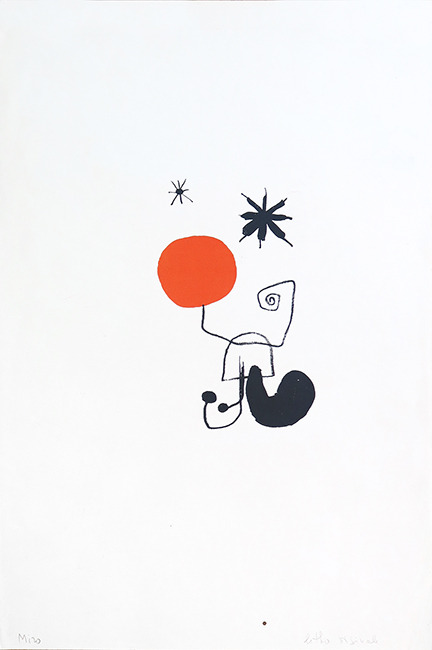






I love how 'brutal’ these works are. They just are as they are. To me they have this 'I don’t care what you think’ attitude to them. They’re honest and stark and chaotic and plain at the same time. I also like the different tones of black, like different amount of water have been used to water down the paint or ink, it gives the works a depth to them. It’s also nice with the kind of 'scratchy’ background, gives everything else this 'layer’ to sit on.
0 notes
Photo

"My narrative art is a visual journal of personal observations, life experiences and socio-political issues. I value expression over perfection and with a medley of abstract and iconographic images that are juxtaposed in multiple layers, my art incorporates mystical symbolism, inviting the viewer to observe, reflect, and respond..." --Nimi Trehan, artist
Visit Nimi's Studio on October 8.
Register here: bit.ly/aacc-oct8-nimi-trehan
Images by Nimi Trehan. Clockwise: Haven, Architectural Mayhem, Calm within Chaos, Aurora 9.
0 notes
Text
ARTIST RESEARCH
JOAN MIRÓ
Punyet Miró, Joan, et al. Miro: In His Studio. Thames and Hudson, 1996.
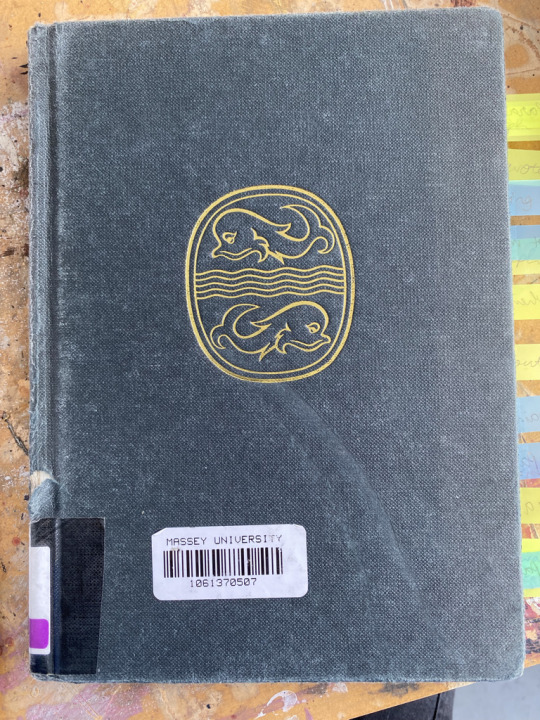


It was suggested that I look into Joan Miró and so I went to the library and got the book 'Miro: In His Studio' out. It's mostly a book of photographs from in his studio but there are a few pages of written content about Miro's life and practice.
Below are a few quotes and paragraphs from the book that I thought were interesting and relevant:
"Not many photographers were given the opportunity of photographing Miró in his studio, because the artist could not endure the presence of strangers in his working quarters" (Punyet Miró, et al. 8).
"'I paint what I am, ' declared Miró one day, with reference to his own taciturn, over-sensitive and melancholic temperament. His paintings reproduce perceptions and objects which, having been submitted to a process of transformation and metamorphosis, have assumed the new identity attached to them by the artist. This process occurs automatically and/or subconsciously" (Punyet Miró, et al. 8).
"'My painting bears no resemblance to a private journal. It is an irresistible compulsion that manifests itself externally,' he said in 1978. This necessity to reveal the irresistible compulsion externally undoubtedly helped him to battle on and, finally, to continue to live" (Punyet Miró, et al. 8).
"An evening walk together in his garden was the best way of entertaining his world; he used to teach me how to listen to the silence, how to look at things in the dark, how to communicate without words. His blue eyes, in which could be read the avidity and lightness of his soul, transmitted this intangible poetry". (Punyet Miró, et al. 9).
"Throughout his life he was obsessed with freedom of expression, made manifest in a plastic and iconographic idiom that could be understood by all, but which he alone was capable of producing. 'I never dream when I am asleep, I only dream when I am not asleep,' said Miró..." (Punyet Miró, et al. 9).
"When he was tired he would go up to his study to listen to classical music or read poetry" (Punyet Miró, et al. 9).
"The world created by Miró had enormous imaginative strength. It was fundamentally linked to elements that were very humdrum or alternatively very poetic. This was possible thanks to the complicity inherent in his work between free poetic association and his own acute visual sensitivity" (Punyet Miró, et al. 10).
"For the artist the space had religious significance. It was a place for meditation, solitude and creation. The only sounds were his breathing and the creaking of his rocking chair when he sat down to think" (Punyet Miró, et al. 10).
"Miró concentrated very intensely when he was working, lying in wait for the slightest incident, the spark that would lead him towards new perspectives, towards the creation of the tangle of signs that would translate arbitrarily into poetic language, or into musical-chromatic composition. In the 1970s, Miró finally admitted that he was working 'in a second state, with unfettered violence, so that people should see he was still alive and that he was still moving towards new horizons'" (Punyet Miró, et al. 11).
"The Sert studio offered Miró the working environment that he needed. When he closed the door he knew that he was shutting himself away from all contact with the outside world and entering the private world of his imagination. This private world, Miró's reality, was filled with Mediterranean light, forms and colours" (Punyet Miró, et al. 12).
"In 1978 he explained that 'my present absorption in all these bits and pieces, in all these treasures, is quite new. I've been hypnotized. When I go for a walk I don't hunt for objects as if I were looking for mushrooms. There's a sudden force, bang! like a magnetic force that makes me look down at a certain moment'" (Punyet Miró, et al. 12).
"As Breton observed: 'Experiment is not a matter of passive observation; it is the invention of a new kind of experience made possible by allowing reason to confirm what tactile experience might seem to deny.' Every object possessed by magic or almost sacred properties, to which Miró gave a semi-religious significance. The signifier remained the same but the signified altered to place the object in a new context, a context marked by metaphor and by the distillation of intuition" (Punyet Miró, et al. 13).
"As my brother David commented, however: 'For Miró the most important factors were his own reaction to his work, his self-discipline and he adherence to the highest standards 0 the last two testifying to his faultless honesty. He also maintained a constant development in his work and a provocative spirit that never left him'" (Punyet Miró, et al. 13).
"When I analysed the colours used by Miró in his late work I realized that black was predominant and had become in fact the background colour to all his painting" (Punyet Miró, et al. 14).
"Miró always sailed on unchartered waters and dared to criss-cross them in search of the unknown. His interior aggression and perseverance stimulated him to continue the search and provided material for the continuous development he needed" (Punyet Miró, et al. 14).
"Miró devoted his whole life to the reassertion of artistic and spiritual liberty; even though he wanted to escape the cult of the artist he could not deny the strength and pragmatic nature of his own work" (Punyet Miró, et al. 15).

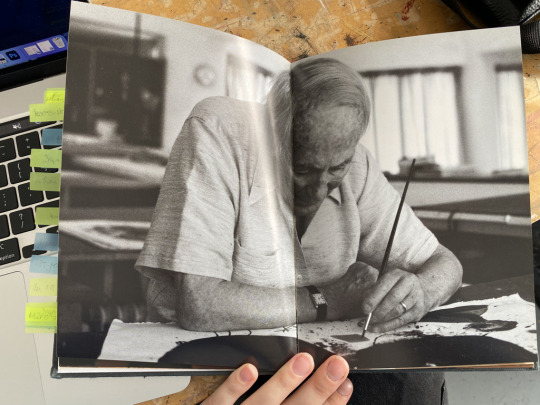
^ Photos from some of the photo pages in the book.
Joan Miró was a Spanish painter, sculptor and ceramicist. "Earning international acclaim, his work has been interpreted as Surrealism but with a personal style, sometimes also veering into Fauvism and Expressionism. He was notable for his interest in the unconscious or the subconscious mind, reflected in his re-creation of the childlike" - Tate.


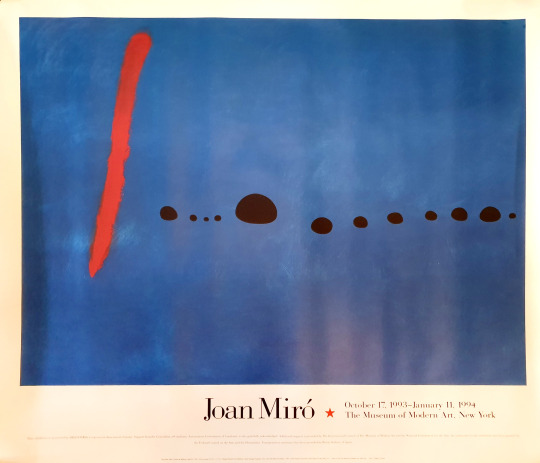




I love how 'brutal' these works are. They just are as they are. To me they have this 'I don't care what you think' attitude to them. They're honest and stark and chaotic and plain at the same time. I also like the different tones of black, like different amount of water have been used to water down the paint or ink, it gives the works a depth to them. It's also nice with the kind of 'scratchy' background, gives everything else this 'layer' to sit on.
0 notes